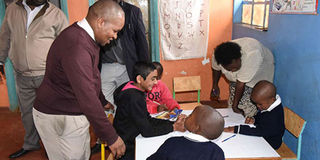State performs poorly in special schools sector

Family Bank's Eldoret branch manager spends time with pupils at Autism Centre, at Sosiani Primary School in Eldoret, on June 28, 2018. The Ministry of Education spends Sh455 million on learners with special needs in basic education. PHOTO | FILE | NATION MEDIA GROUP
What you need to know:
- Religious organisations, like the Salvation Army, have been at the forefront in providing education for children with disabilities.
- As the second term comes to an end, the schools have received less than 50 per cent of the total funding expected for the year.
Special needs education (SNE) in the country is underfunded, understaffed, neglected, congested and stigmatised, placing a heavy load on school administrators, a survey by the Nation has shown.
The schools take care of more than 125,000 learners with disabilities across the country. Many of them can barely survive on government funding and have to rely on well-wishers or adapt to make ends meet.
Many special schools the Nation visited lack disability-friendly classrooms, dormitories and playgrounds since many of them were built when such concepts had not been mainstreamed, and no adjustments have been made ever since.
Some of the dormitories also fall short of the Ministry of Education guidelines on safety.
At Joytown Secondary School in Thika, which has 292 students, the dormitories are congested and the students have to sleep on double-decker beds, despite most of them having physical disabilities and use either wheelchairs or crutches.
There is little space in the isles, making movement inside the dormitories quite a challenge.
INADEQUATE RESOURCES
At another special school, the windows are too high for the learners to open and have metal grilles. This goes against the safety guidelines, which requires dormitory windows to have no barriers and to open outwards.
“Enrolment has risen due to sensitisation campaigns. It is a good thing, but it has put a strain on resources available at school,” Mr Raphael Aura, the chairperson of the Kenya Special Schools Principals Association, said.
Special schools also lack medical facilities and trained personnel to take care of the learners. This year, four students of Joytown have died due to various complications. The school has a clinic and one nurse.
“I work round the clock since this is more like a school and a hospital at the same time,” said Ms Sophie Kamau, the nurse.
She said that they have been forced to compromise on the students’ diet as the school cannot afford the dietary needs the health conditions of the learners demand.
The most common health conditions are brittle bones, muscular dystrophy, spina bifida, epilepsy and a few cases of HIV/Aids.
EXAMINATION
Learners in special schools also have high absenteeism rates as they seek medical care, with some occasionally being hospitalised.
“The setting and marking of examinations need to be re-evaluated. You cannot use the same yardstick used to measure learners who are always in school to grade these children,” Mr John Mwenji, a parent, said.
His son writes slowly because of a muscular problem that causes his hands to shake, affecting the legibility of his handwriting.
Though the Kenya National Examinations Council allocates extra time for candidates with special needs, Mr Mwenji says more should be done.
But Director of Special Needs Education Fredrick Haga disagrees. “We don’t want to sympathise. Even those without disability might not finish (writing the exam),” he told the Nation.
He said the council usually assesses the candidates before the examination to see the kind of assistance they might need.
The lack of attention to this category of learners is not a recent thing, since most special schools were not started by the government.
FUNDING
Religious organisations, like the Salvation Army, have been at the forefront in providing education for children with disabilities, alongside a non-governmental and charitable organisations.
Mr Haga says SNE falls into four categories: where disabilities that does not affect learning; disabilities that slightly affect learning but require modification (adaptation) for effective learning; disabilities that requires much more than is provided (specialised curriculum), and severe disabilities that make learning difficult due to cognitive limitations and call for a different (stage-based) curriculum.
The Ministry of Education spends Sh455 million on learners with special needs in basic education.
It gives the regular capitation of Sh1,420 per learner under the Free Primary Education programme and tops it up with an extra Sh2,300, making a total of Sh3,700 per year.
In secondary schools, the government allocates Sh57,700 per learner in a boarding school per year, which is Sh35,460 more than 'other' students get. There are 4,724 learners in secondary schools.
But school heads say this is not enough since the learners require specialised attention. And they have to employ extra staff like house parents, physiotherapists and nurses, buy specialised learning materials and equipment, food and medicine.
As the second term comes to an end, the schools have received less than 50 per cent of the total funding expected for the year.





